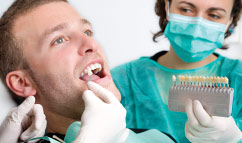Great Expectations — Perceptions in Smile Design
Is what you get what you want?
(Continued)
The Doctor's Perspective
an analysis by Dr. Gerard Chiche
An Expert Dentist's Perspective
 |
| Figure 3: An example of a “perfect-minded” patient's veneer restoration with perfect crown form and bright, white tooth color. |
 |
| Figure 4: An example of a restoration showing minor irregularities on the incisal edges (tips) of the teeth with a more natural tooth color blending into the adjacent teeth for a “natural-minded” person. |
| Photos provided of Dr. Girard Chiche |
When a person comes to consult for aesthetic treatment — smile change or enhancement — the consultation appointment is divided into a “conventional” evaluation (with charting, periodontal (gum), occlusal (bite) and radiographic (x-ray) surveys, as well as diagnostic study models) and an “aesthetic” evaluation involving an aesthetic analysis and a focus on the patient's subjective aesthetic requests.
Two Types of Patients
The media image displayed in many advertisements has a very strong influence in contemporary dental treatment. In my opinion, today's smile is becoming an increasing part of a youthful dynamic appearance. It is characterized by whiter teeth, which often fall beyond the range of traditional shade guides (“Hollywood White”).
From my standpoint as a clinician, it is possible to identify two types of people: “Perfect-Minded” (the Hollywood Smile) and “Natural-Minded.”
The “Perfect-Minded” Patient
Patients who fall into the category of the “perfect-minded” will typically expect maximum regularity and alignment along with maximum brightness [Figure 3]. Part of the art of smile enhancement and imparting a natural appearance is to make certain features invisible and other features more visible. This is really where science and art meet in dentistry. Knowing what can and cannot change to create the perception of reality is a very important concept, not only for smile enhancement but for the human body generally. Nobody is completely the same on each side, but if there are significant differences between the right and left sides, they can become noticeable and distracting.
To ensure that a smile looks right it will be critical to provide patients with a smile that is symmetrical. In other words, if you were to draw a vertical line down the middle of the face, which we call the midline, that line would be directly between the front teeth, and around it the smile will look “balanced” from one side to the other. This is also true in a horizontal dimension, creating a regular smile line that matches the curvature of the lower lip. Now each tooth type is made to fit into this framework with symmetrical central incisors, lateral incisors and canines, along with gum lines that also match from one side to the other.
The “Natural-Minded” Patient

Adding artistic “natural” touches to teeth can make them look just different enough to create real character. Those individuals who want a more natural or subtle look, what I call the “Natural-Minded,” will typically expect a general sense of regularity and alignment along with definite “brightness,” but do not wish their teeth to be noticed at every turn. In any pleasing smile, tooth symmetry is found close to the midline; therefore the central incisors — the two upper front teeth — must be mostly symmetrical with only minor irregularities [Figure 4].
The main “asymmetry” (a-without, symmetry-matching), where individual characterizations can be added, can be provided between the lateral incisors, the teeth on either side of the two front teeth. The canines (“eye” teeth) will also provide minor asymmetry, as their gingival margins (gum lines) and their cusp tips (points of the teeth) do not need to be level horizontally. The depth of the incisal embrasures (the way the teeth line up and change shape going from the front to the back of the mouth) should be of a natural depth in addition to providing a natural progression. These pictures also illustrate the need to provide these individuals with subtle “polychromatic effects” (“poly” – many, “chromatic” – color), mimicking in every detail what makes teeth look normal and absolutely natural.

